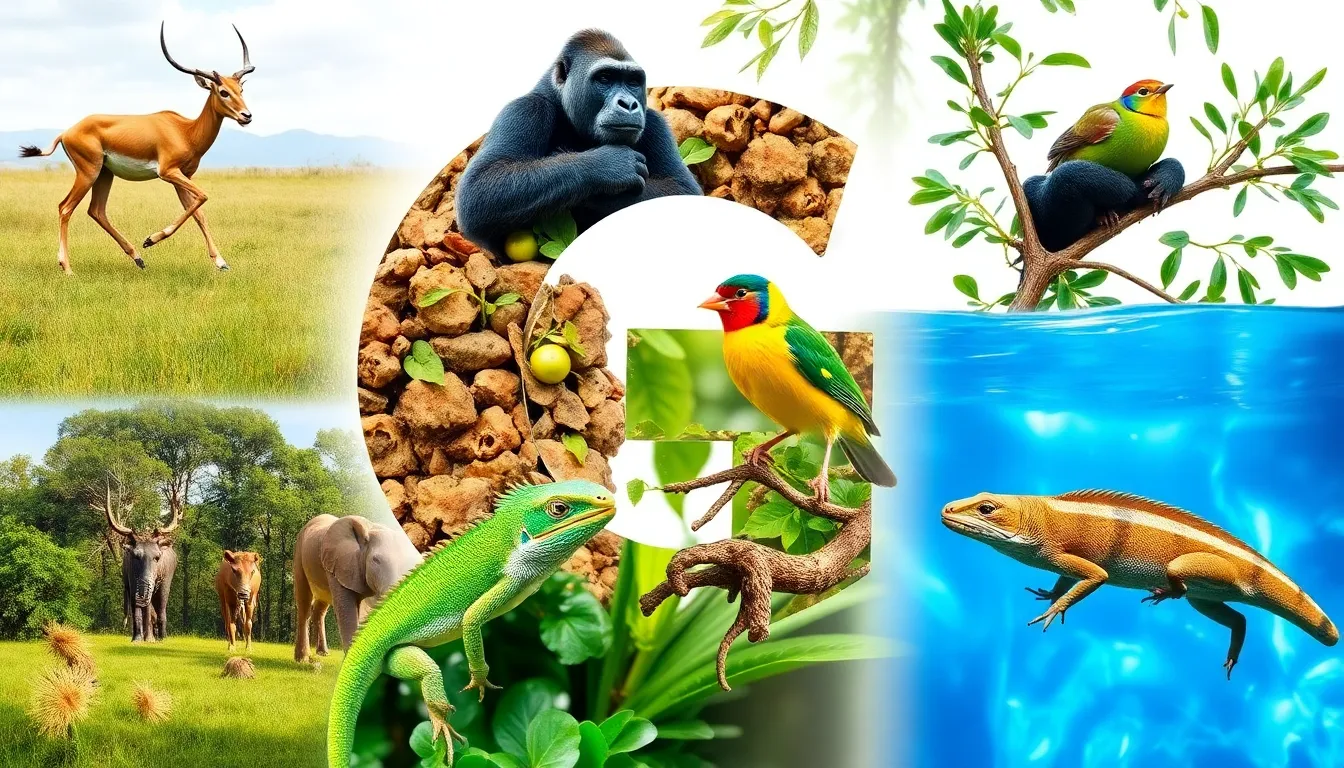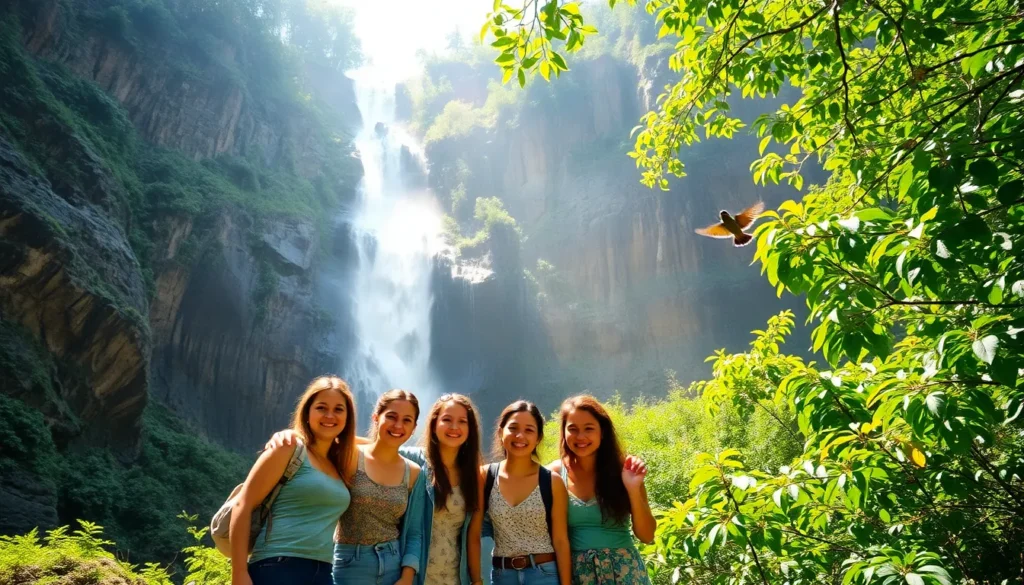Table of Contents
ToggleFrom the graceful gazelle to the mighty gorilla, the animal kingdom is full of fascinating creatures that start with the letter G. Each of these animals showcases unique traits and behaviors that capture the imagination. Exploring these diverse species not only enriches one’s understanding of wildlife but also highlights the importance of biodiversity.
Whether it’s the playful gibbon swinging through the trees or the elusive gecko blending into its surroundings, animals that begin with G offer a glimpse into the wonders of nature. This article dives into a selection of these intriguing animals, revealing their habitats, characteristics, and roles in their ecosystems. Join the journey and discover the remarkable world of G-named animals.
Overview of Animals That Start With A G
Animals that begin with the letter G exhibit a range of remarkable characteristics and adaptations. Below are several notable examples:
- Gazelles: Known for their speed and grace, gazelles inhabit grasslands and savannas in Africa and Asia. They possess strong legs, enabling them to escape predators with quick, agile movements.
- Gorillas: As the largest primates, gorillas reside in the forests of central Africa. They exhibit complex social structures and communicate through vocalizations and body language, emphasizing their intelligence.
- Gibbons: These small, arboreal apes are native to the tropical forests of Southeast Asia. Gibbons are known for their distinctive calls and acrobatic swinging through trees, showcasing their agility and social behavior.
- Geckos: This diverse group of lizards can be found in warm climates around the world. Geckos possess unique adhesive toe pads, allowing them to climb smooth surfaces and navigate vertical environments.
- Giraffes: Giraffes, the tallest land animals, thrive in African savannas. Their long necks and patterns help them reach leaves in tall trees, reducing competition for food with other herbivores.
Each of these animals plays a crucial role in their respective ecosystems, contributing to biodiversity and ecological balance. Understanding their adaptations and behaviors fosters greater appreciation for wildlife conservation.
Types of Animals That Start With A G

Many animals starting with the letter G fill various ecosystems. Each category includes distinctive characteristics and roles within their environments.
Mammals
- Gazelles: Known for their incredible speed, gazelles can reach up to 60 km/h. They inhabit grasslands and savannas.
- Gorillas: The largest primates, gorillas exhibit intricate social structures. They communicate using gestures and vocalizations.
- Gibbons: Recognized for their agility, gibbons swing through trees, covering distances swiftly. Their songs serve to establish territory.
- Guanacos: Similar to llamas, guanacos live in South American grasslands. They can sprint at speeds exceeding 56 km/h.
- Gophers: These small rodents burrow underground. Gophers play essential roles in aerating the soil.
Birds
- Geese: Social and migratory, geese travel in flocks. Their honking calls and V-shaped formations mark their journeys.
- Gulls: Found near coastlines and lakes, gulls scavenge for food. They’re known for their adaptability to urban environments.
- Goldfinches: Brightly colored, goldfinches feed on seeds and are common in North America. Their songs attract mates during the breeding season.
- Great Horned Owls: Recognizable by their tufts, these owls are powerful predators. They occupy diverse habitats from forests to deserts.
- Grackles: These iridescent birds gather in large flocks. Grackles show intelligence through problem-solving behaviors.
Reptiles
- Geckos: Known for their unique adhesive toe pads, geckos efficiently climb vertical surfaces. They communicate with vocalizations and body language.
- Gophersnakes: These non-venomous snakes mimic rattlesnakes to deter predators. They inhabit a range of environments including grasslands.
- Green Iguanas: Herbivorous and arboreal, green iguanas can reach lengths of up to 6.5 feet. Their vibrant coloration often aids in camouflage.
- Galápagos Tortoises: These giant tortoises live on the Galápagos Islands. They are known for their longevity and role in shaping their habitats.
- Garner’s Snakes: These small, non-venomous snakes are found in various habitats. They primarily feed on small rodents and insects.
Amphibians
- Green Tree Frogs: Recognizable by their bright green coloration, these frogs reside in trees and require moist environments for breeding.
- Giant Salamanders: Among the largest amphibians, giant salamanders can grow over 1.5 meters long. They inhabit freshwater rivers and streams.
- Golden Poison Dart Frogs: Known for their toxicity, these frogs inhabit rainforests. Their bright coloration acts as a warning to potential predators.
- Gilled Salamanders: Found in aquatic environments, gilled salamanders undergo a unique life cycle, retaining gills into adulthood.
- Granular Poison Frogs: These small frogs possess skin toxins that deter predators. They thrive in humid areas, relying on moist conditions.
Fish
- Guppies: Popular in aquariums, guppies are small, colorful fish that reproduce rapidly. They contribute to freshwater ecosystems by controlling mosquito populations.
- Goldfish: Common household pets, goldfish can adapt to various water conditions. Their bright colors and varied shapes make them appealing to fish enthusiasts.
- Goliath Grouper: Reaching up to 450 pounds, this fish prefers warm coastal waters. It’s known for its large size and impressive diving abilities.
- Garfish: Characterized by their elongated bodies, garfish inhabit both freshwater and saltwater. They are known for their sharp teeth and green bones.
- Grunt Fish: These fish produce grunting sounds using their swim bladders. Commonly found in tropical waters, they often form schools.
Interesting Facts About G Animals
G animals exhibit remarkable adaptations and thrive in diverse habitats, showcasing their crucial roles in ecosystems. Understanding these characteristics offers deeper insights into the significance of biodiversity.
Unique Adaptations
- Gazelles: Exhibiting exceptional speed, gazelles can reach up to 60 miles per hour, allowing them to escape predators effectively.
- Gorillas: Gorillas adapt to their environment through strong social bonds, with troop structures that enhance protection and resource sharing.
- Gibbons: Gibbons possess elongated arms and strong shoulder muscles, facilitating impressive swinging movements through trees.
- Geckos: Geckos feature specialized toe pads that enable climbing on various surfaces, including vertical walls and ceilings.
- Giraffes: Giraffes adapt to their habitat by having long necks, allowing them to reach leaves and fruits high in trees, minimizing competition for food.
Habitat Diversity
- Guanacos: Found in the open grasslands of South America, guanacos thrive in arid environments, showcasing adaptability to harsh conditions.
- Geese: Geese occupy various habitats, including wetlands, urban areas, and agricultural lands, reflecting their adaptability to different ecosystems.
- Great Horned Owls: These owls inhabit diverse environments, from forests to deserts, utilizing their versatile hunting skills.
- Gophersnakes: Gophersnakes live in habitats ranging from grasslands to forests, demonstrating adaptability through their ability to burrow and navigate different terrains.
- Green Tree Frogs: Preferring freshwater ecosystems, green tree frogs adapt their life cycles to seasonal changes, showcasing their resilience in varying conditions.
Conservation Status of G Species
Many species that start with the letter G face various threats, impacting their populations and conservation status. Understanding these threats is essential for implementing effective conservation strategies.
| Species | Conservation Status | Major Threats |
|---|---|---|
| Gazelle | Vulnerable | Habitat loss, poaching |
| Gorilla | Critically Endangered | Habitat destruction, illegal hunting |
| Gibbon | Endangered | Deforestation, habitat fragmentation |
| Gecko | Least Concern | Habitat loss, invasive species |
| Giraffe | Vulnerable | Habitat destruction, poaching |
| Guanaco | Near Threatened | Hunting, habitat degradation |
| Goose | Least Concern | Habitat loss, climate change |
| Great Horned Owl | Least Concern | Habitat modification, rodenticide use |
| Gophersnake | Near Threatened | Habitat loss, road mortality |
| Green Tree Frog | Least Concern | Habitat loss, pollution |
Gazelles, categorized as vulnerable, confront habitat loss from agricultural expansion and poaching for their meat and horns. Gorillas, labeled critically endangered, suffer from habitat destruction and illegal hunting driven by bushmeat trade. Gibbons, listed as endangered, struggle due to deforestation and habitat fragmentation, resulting from logging and agricultural activities.
Geckos generally maintain a status of least concern, though habitat loss and competition from invasive species threaten some local populations. Giraffes, classified as vulnerable, face threats from habitat destruction and poaching for their hides and meat. Guanacos are near threatened due to hunting pressures and habitat degradation caused by livestock grazing.
Geese and great horned owls remain least concern, despite experiencing habitat loss and pressures from climate change, which affects their breeding grounds and food sources. Gophersnakes face near threatened status primarily due to habitat loss and road mortality, while green tree frogs maintain a least concern status despite threats from habitat loss and pollution.
Conservation efforts for these species involve habitat protection, anti-poaching initiatives, public awareness campaigns, and restoration projects aimed at ensuring their survival in the wild.
Exploring animals that start with G reveals a rich tapestry of biodiversity that underscores the importance of conservation. Each species plays a vital role in its ecosystem, contributing to the balance of nature. From the speed of gazelles to the social structures of gorillas, the adaptations of these animals are nothing short of remarkable.
As many of these species face significant threats, awareness and action are crucial. Protecting their habitats and supporting conservation efforts can help ensure these incredible creatures continue to thrive. By appreciating the diversity of life that begins with G, readers can foster a deeper connection to wildlife and the natural world.







